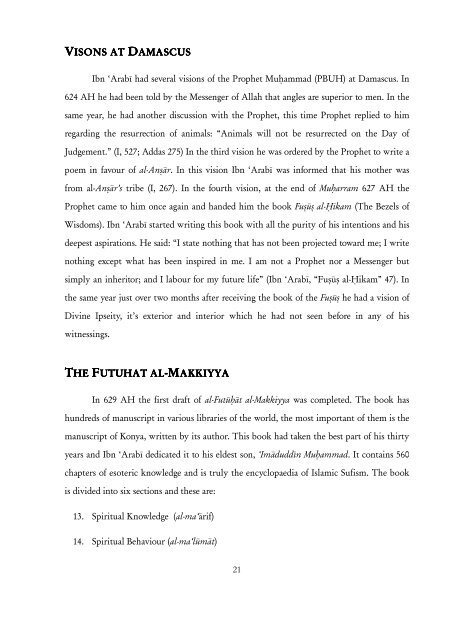17234271-Saykh-al-Akbar-Ibn-Arabī-brief-biography
17234271-Saykh-al-Akbar-Ibn-Arabī-brief-biography
17234271-Saykh-al-Akbar-Ibn-Arabī-brief-biography
Create successful ePaper yourself
Turn your PDF publications into a flip-book with our unique Google optimized e-Paper software.
VISONS AT DAMASCUS<br />
<strong>Ibn</strong> ‘Arab┘ had sever<strong>al</strong> visions of the Prophet Mu╒ammad (PBUH) at Damascus. In<br />
624 AH he had been told by the Messenger of Allah that angles are superior to men. In the<br />
same year, he had another discussion with the Prophet, this time Prophet replied to him<br />
regarding the resurrection of anim<strong>al</strong>s: “Anim<strong>al</strong>s will not be resurrected on the Day of<br />
Judgement.” (I, 527; Addas 275) In the third vision he was ordered by the Prophet to write a<br />
poem in favour of <strong>al</strong>-An╖┐r. In this vision <strong>Ibn</strong> ‘Arab┘ was informed that his mother was<br />
from <strong>al</strong>-An╖┐r’s tribe (I, 267). In the fourth vision, at the end of Mu╒arram 627 AH the<br />
Prophet came to him once again and handed him the book Fu╖┴╖ <strong>al</strong>-╓ikam (The Bezels of<br />
Wisdoms). <strong>Ibn</strong> ‘Arab┘ started writing this book with <strong>al</strong>l the purity of his intentions and his<br />
deepest aspirations. He said: “I state nothing that has not been projected toward me; I write<br />
nothing except what has been inspired in me. I am not a Prophet nor a Messenger but<br />
simply an inheritor; and I labour for my future life” (<strong>Ibn</strong> ‘Arab┘, “Fu╖┴╖ <strong>al</strong>-╓ikam” 47). In<br />
the same year just over two months after receiving the book of the Fu╖┴╖ he had a vision of<br />
Divine Ipseity, it’s exterior and interior which he had not seen before in any of his<br />
witnessings.<br />
THE<br />
FUTUHAT AL-MAKKIYYA<br />
AKKIYYA<br />
In 629 AH the first draft of <strong>al</strong>-Fut┴╒┐t <strong>al</strong>-Makkiyya was completed. The book has<br />
hundreds of manuscript in various libraries of the world, the most important of them is the<br />
manuscript of Konya, written by its author. This book had taken the best part of his thirty<br />
years and <strong>Ibn</strong> ‘Arab┘ dedicated it to his eldest son, ‘Im┐dudd┘n Mu╒ammad. It contains 560<br />
chapters of esoteric knowledge and is truly the encyclopaedia of Islamic Sufism. The book<br />
is divided into six sections and these are:<br />
13. Spiritu<strong>al</strong> Knowledge (<strong>al</strong>-ma‘┐rif)<br />
14. Spiritu<strong>al</strong> Behaviour (<strong>al</strong>-ma‘l┴m┐t)<br />
21


